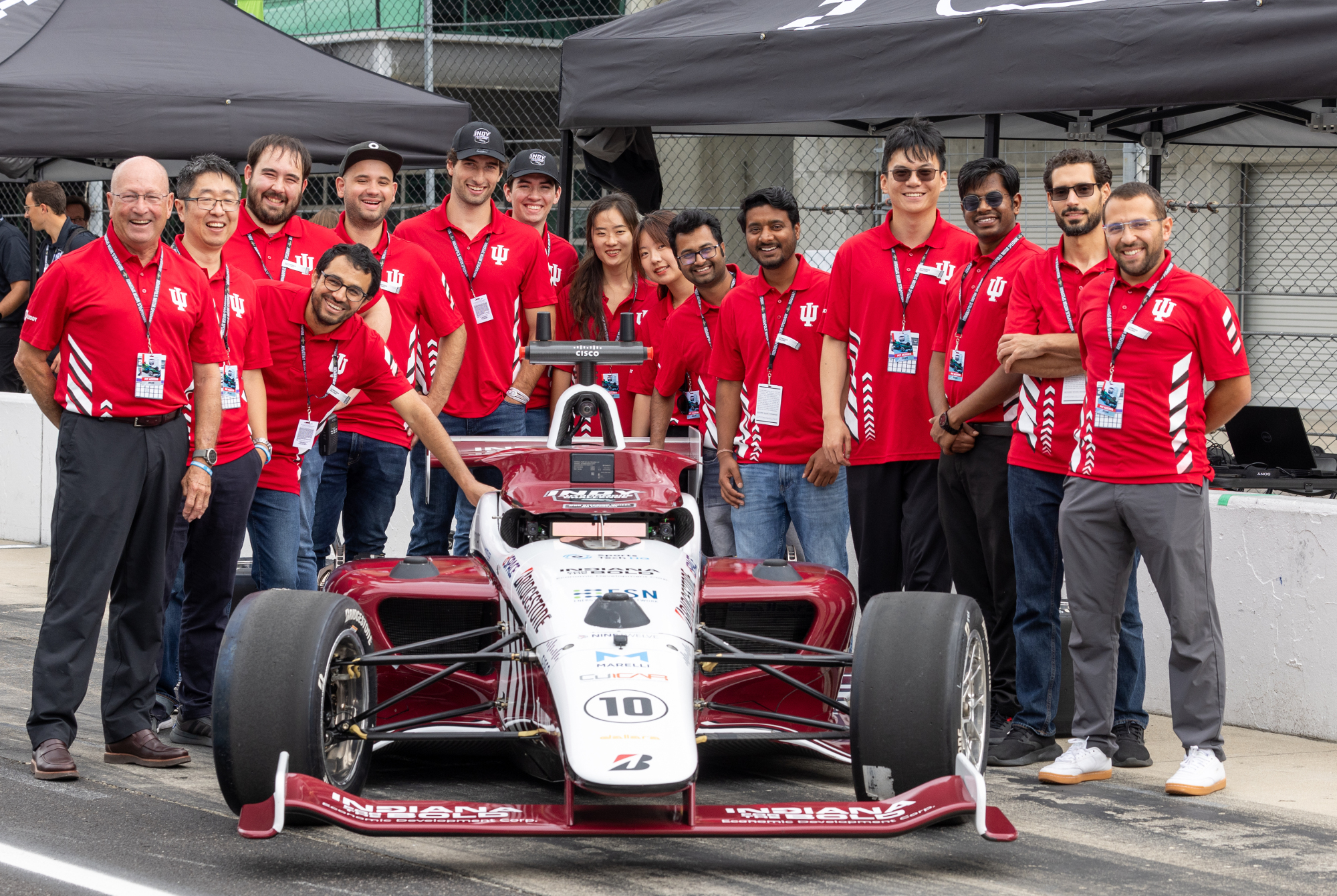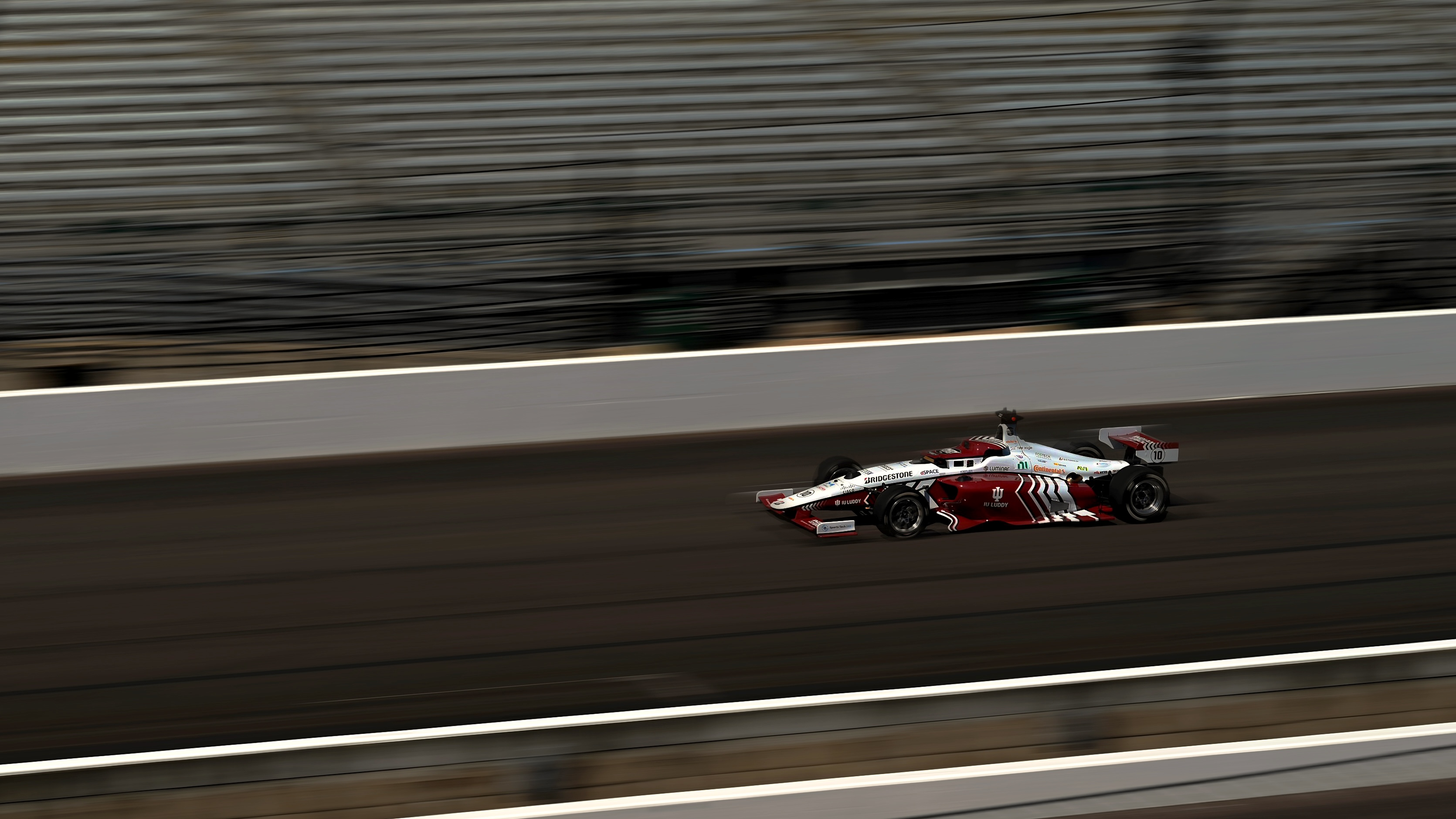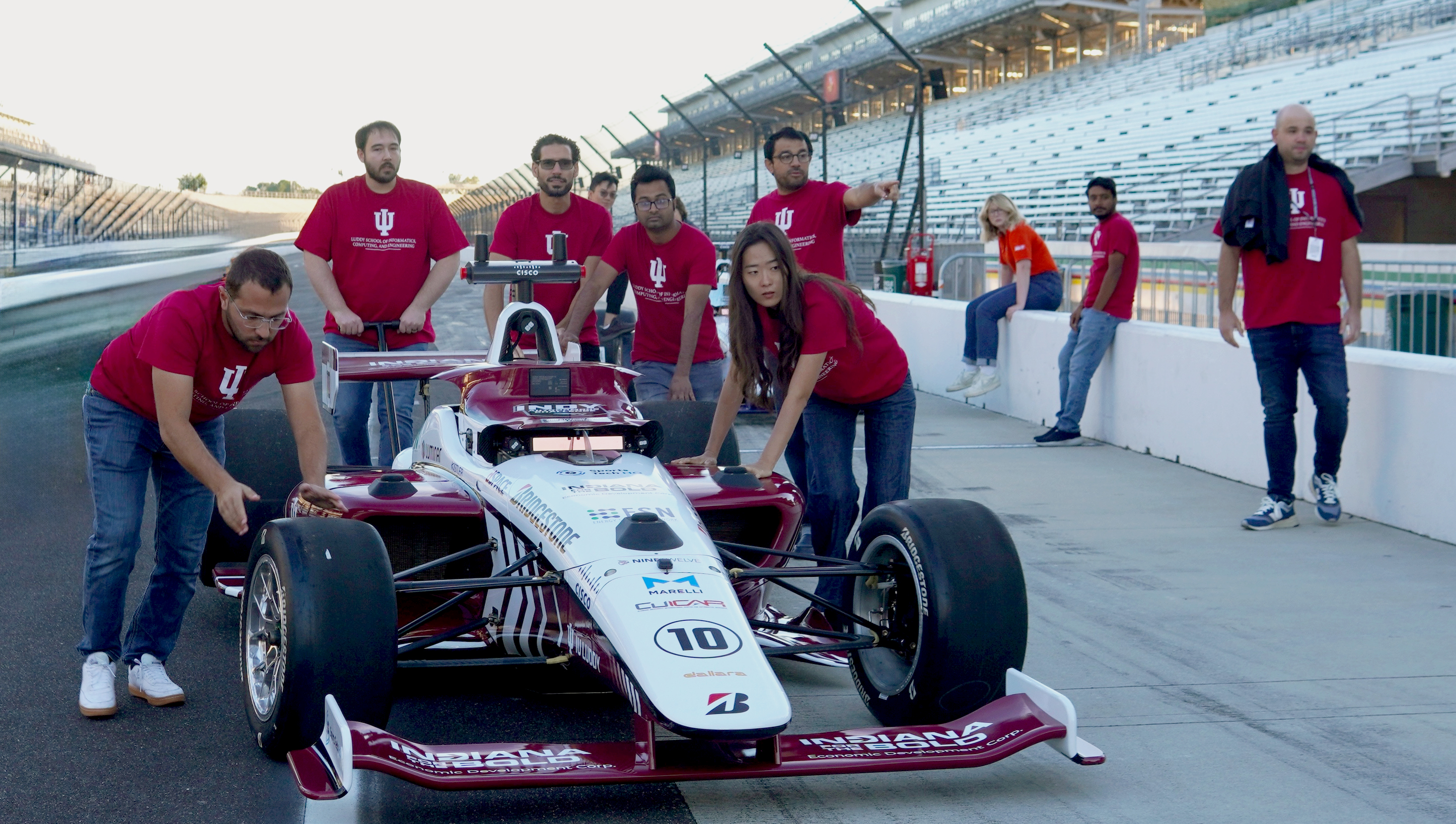Rain didn’t matter. Not to Lantao Liu, associate professor of Intelligent Systems Engineering and Computer Science at the Luddy School of Informatics, Computing, and Engineering. Not to his newly formed Indiana University Luddy Autonomous Racing team. Not with a hard-earned Indy Autonomous Challenge achievement at the Indianapolis Motor Speedway, and the promise of more to come.
“No pain, no gain,” Liu said with a smile under a tent a few yards from the track, “but the pain is pretty hard.”
Pain became reward when the IU Luddy team debuted its AI driven, 1,400-pound Indy Lights race car to speeds up to 130 mph during the Sept. 6 Challenge. Its 124-mph peak one-lap average around the Speedway’s iconic 2.5-mile oval -- following averages of 111 mph and 121 mph -- signified an achievement many thought was impossible for a team with less than a year of developmental time.
“I feel relief,” said team lead and fourth-year Intelligent Systems Engineering Ph.D. student Durgakant Pushp. “I feel we accomplished something. We planned for it; we executed it; and we achieved it. Now, we have more confidence in the way we execute things.”
No Indy Autonomous Challenge team had ever gone so fast in so little developmental time. Some teams had as much as a four-year head start.
Liu said officials from one team told him the Luddy car was faster than any previous first-year car.
“I received a lot of positive feedback from other teams and the Indy Autonomous Challenge,” he said. “Our team’s achievements stood out. I’m extremely proud of our students.”
The IU Luddy team was up to the challenge with its core of students in Pushp, Hassan Jardali, Youwei Yu, Mahmoud Ali, Paul Coen, Alejandro Murillo-Gonzalez, Ihab Mohamed, MD Al-Masrur Khan, Saeoul Park, Lingchuan Zhou, Reddy Charan Pulivendula, Paul Quigley and Sam Huser.
These Ph.D., master’s and undergraduate students came from Intelligent Systems Engineering, Computer Science and Informatics. More than 30 students -- including recent graduates -- contributed to the project.
The IU Luddy team began working on the project last fall, but didn’t get its car -- the $1-million IAC Dallara AV-24 powered by a 488 horsepower Honda racing engine -- until the middle of July, three months later than expected. It got testing time at Kentucky Speedway and the Indianapolis Motor Speedway to make rapid progress, then had a major setback due to hardware issues with several PCIe ports, along with a communication failure with the onboard computer. That caused a crash two days before the Sept. 6 event to jeopardize everything.
Liu and his team refused to let that happen.

A midnight brain-storming session was followed by an all-nighter. They had to figure out what had caused the car to enter emergency mode, freeze up and hit a turn 2 tire wall at 40 mph, damaging its front cone and wheel suspension. They thought they had the answer, and implemented it, but had no guarantee. They just knew the problem wasn’t with their algorithm.
“We had some theories,” Pushp said, “but nothing definitive. We worked on all the possibilities and went with our best solution because there wasn’t time for anything else.”
A flawless Sept. 6 morning test at a conservative 95 mph offered hope. The IU Luddy team would get its afternoon Challenge shot, and when it was over, when a car that featured three GPS with six antennas, two radar sensors, three lidar sensors, six optical cameras and an AI driver stack rather than a human driver completed five laps without a crash or a glitch faster than it had ever gone before, the pride and relief were palpable.
“This is like landing a moon shot, like landing a rover on Mars,” Liu said. “We never tested; we ran today; and it worked.”
This wasn’t just racing for the thrill of competition. Benefits will extend to everyday life.
“A lot of what we’re developing can potentially be extended into consumer cars one day to improve the safety and reaction speed of future autonomous vehicles,” said Coen, a second-year Computer Science Ph.D. student.
Praise followed in the aftermath. Luddy Dean Joanna Millunchick said, “I am so incredibly proud. There were those who didn’t think we could pull this off, but I was never daunted.”
Added Beth Plale, ISE chair: “This is such a great performance. There is quite a bit of buzz among the students.”
The University of Virginia’s Cavalier Autonomous Racing team beat out nine other university teams from around the world at the rain-delayed Challenge with its winning 171 mph lap average. It set a world autonomous racetrack record with a top speed of 184 mph. The record speed for autonomous race cars is 192.2 mph on a straight track at the Kennedy Space Center.
For comparison, the winning human driver of the first Indy 500 in 1911 had an average speed of 74.6 mph.
As the IU-Luddy team proved, success isn’t always measured by victory. Sometimes you dare greatly, fail, try again, fail again, try again and, if you care enough, push enough, work enough, believe enough, you prevail.
Lantao and his team are proof of that and are ready for more. The next event is in January in Las Vegas.
“We’ll be better,” Liu said.
How much better?
“I can’t give you a number,” he said with a laugh, “but everyone is happy. We did not try our maximum speed. We wanted to be safe. We didn’t want something to occur.”
That’s part of the story. Here’s the rest.

Drones buzzed above the Indianapolis Motor Speedway track. Opening ceremonies for the Indy Autonomous Challenge had begun with an announcing twist to the traditional Indy 500 introduction:
“Ladies and gentlemen, start your software.”
Ten competing teams included ones from institutions in Korea, Germany and Italy, as well as U.S. universities such as the University of California Berkeley with teaming universities Carnegie Mellon University and the University of San Diego, the University of Virginia, Purdue University, Auburn University and Caltech.
The Challenge aims to advance technology that can accelerate the commercialization of fully autonomous vehicles and the use of advanced driver-assistance systems to improve safety and performance in racing and everyday life.
The Challenge also provides opportunities, through real and simulated environments, for students to thrive in Science, Technology, Engineering, and Math (STEM).
The day of the competition, more than 1,500 Indiana high school students from 42 schools participated in the STEM Zone, which was designed to inspire the next generation of STEM researchers. The Luddy School had a strong presence with Natalie Edwards, Luddy director of undergraduate recruiting; Bryce Himebaugh, Luddy associate clinical professor of engineering; and Evan Weidner, Luddy ISE major.
The Luddy School had half a season to accomplish what other teams had needed multiple seasons or years, but they had expertise honed by Liu’s Vehicle Autonomy and Intelligence Lab (VAIL), which focuses on improving the autonomy and intelligence of robotic systems for unmanned ground, aerial and aquatic vehicles.
The team refined its AI driver software, resulting in a fully autonomous car, through a month of testing at the Indianapolis Motor Speedway and Kentucky Speedway.
Lantao divided his team into eight groups with different responsibilities.
Jardali, a third-year ISE Ph.D. student, was the planning leader and developed features for the car’s controller. This meant generating the race line the car should follow while the controller sent control commands regarding throttle and steering to ensure the car stayed on the right line.
He said a significant challenge was ensuring that all autonomy modules, including perception, localization, planning and control, functioned together to maintain car control.
“Debugging the reasons behind each behavior, and adjusting our code to efficiently address these issues, presented considerable difficulties,” he said.
Yu, a second-year Intelligent Systems Engineering Ph.D. student, led localization efforts focused on estimating the car’s position, heading and velocity. He used machine learning and advanced computationally efficient methods to address, often in milliseconds because of the car’s speed, multiple real-world problems involving GPS points, time synchronization, tire slippage and more that, if not fixed, could cause a crash.
“We are currently working on building a system dynamics model to better understand how the vehicle interacts with different surfaces,” he said.
Coen, who was co-advised by Liu, David Crandall, Luddy Professor of Computer Science, and Jonathan Dilger, NSWC-Crane Director of Research/Command Chief Scientist, worked on the perception system.
He said one of the biggest problems was developing algorithms to immediately work at real-time racing speeds.
He said most systems are designed for speeds around 70 mph, but the Luddy team needed one capable of handling speeds of 170 mph or more, taking into account factors such as major vibration impacts, long sensor delays and high-speed safety stops.
“It made us think of the challenges we might face and think of ways to operate at high speeds and operating within acceptable tolerances,” Coen said.
Khan, a second-year ISE Ph.D. student, focused on perception through the car’s cameras. He said going from the lab’s small platforms to high-speed racing was “very challenging and very fascinating because when we are in high speed, there is so much risk for crashes. Driving at high speed without crashing is the most challenging part.”
In the final days before the Challenge, Liu and eight Ph.D. students as well as some master’s and undergrad students, worked non-stop to get everything right.
Mission accomplished.
“The hardware tech was new for us,” Kahn said. “I worked on different cameras and they are complex to set up. I had to debug camera issues.”
It was all worth it, he added.
“Besides the research, we have some hands-on engineering work. This is really beneficial for our future goals and jobs.”
Experiential learning has always set the Luddy School apart, and this project has been a difference maker, said Murillo Gonzalez, a second-year ISE Ph.D. student.
“The platform is so different from the platforms we’re used to working on in the lab,” he said. “There we have small-scale robots. This is a huge robot. The risks are very high. Any crash can cost a lot of money.”
The hands-on experience, he added, is invaluable.
“Robotics by itself is a lot of hands-on work. There’s no way to go around the physics. You need to make the platform work in the real world.
“In this racing setting, you can see how other teams work. You have the experience with working on a team, but also see how others work.”

The IU Luddy team’s lack of time with the race car ratcheted up the pressure and forced everyone to work 12-to-14-hour days starting from the middle of July. Hundreds of hours were spent writing code, analyzing data and building systems. Many didn’t leave the lab until midnight or later.
“We had to decide how to best make use of our resources,” said Ali, a fourth-year Ph.D. student. “We had all this competition and needed fast computations and had to make decisions in milliseconds. We had to be that fast because of how fast the car can run.”
The IU Luddy team had started in the lab with a simulator using a simulated car which mimicked a real car. Then it moved to three simulated races, placing fourth in the first, eighth in the second and sixth in the third.
Then came tests with small robotic cars.
The degree of difficulty soared when the team moved into a real car in outdoor conditions in the middle of July. Team members tested at Kentucky Speedway and the Indianapolis Motor Speedway. The time crunch was brutal given the Sept. 6 Indy Autonomous Challenge date.
“The team did a great job in having the car move to above 100 mph in just one and a half months,” Ali said. “Most teams need more time to reach that milestone.”
When the Challenge moment of truth arrived, key team members gathered at the Speedway’s control room. Other teams were there waiting their turns. They each would get one shot, no delays, no margin for error. Perform or go home.
Pressure was everywhere. So was brilliance, effort, tenacity and a belief that the future, as it pertained to autonomous racing cars and driving in general, was here, and the Luddy School was at the forefront.
And then the team proved it.
“Before coming to the track,” Pushp said, “the entire team came together with all of us knowing our strong points and weak points. We decided that success was going over 100 mph and coming back safely. We went 124, the best speed we have achieved, and came back safely. It happened in the competition, the best time to achieve your record. This was the best possible outcome.”
Supporters attending the event included Gene Renuart, retired Air Force general and former commander of North American Aerospace Defense Command (NORAD), and founder and president of The Renuart Group, a professional consulting and project management services company.
Other key support came from Travis Brown, Luddy senior executive assistant dean of Innovation; Clayton Nicholas, Indiana University Indianapolis industry research development specialist; Jeff Goetz, IU associate vice president and deputy general counsel; and Brandon Bekkering, IU associate general counsel.
Mohamed, a fourth-year ISE Ph.D. student, said making what they learned in classes applicable in a real-time, real-world situation was invaluable.
We learned so many things from a control point of view about the stability and safety of the car. Now we have to think about the future and how we can control the car in different situations at high speeds.
The future is coming. Imagine what the team will do when it has a full season and more of experience.
“I promise this is just the beginning,” Liu said.

